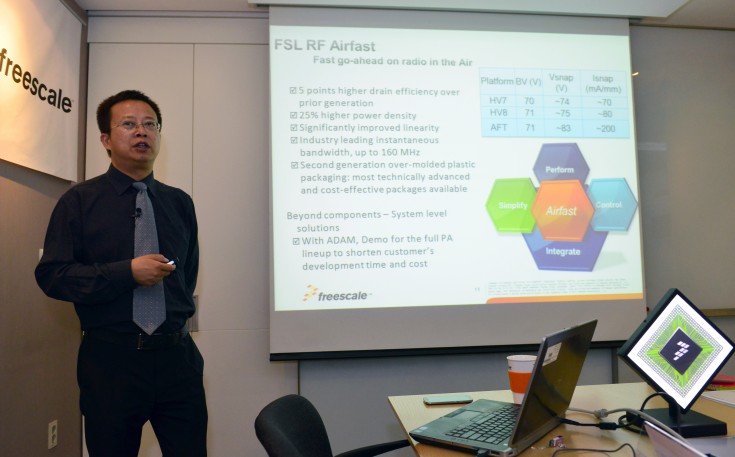Freescale bets on Korea's rapid roll-out of 4G LTE base stations
(iTers News) - You may have no way of knowing that your cell phone keeps talking with a cellular base station even in a standby mode when you don’t use it. Neither might you be aware that the farther you move away from the nearest base station, the higher it amplifies radio signal power not to lose the contact. The vice versa is true of the cellular base station.
That’s the role of what’s called as RF power amplifier, or PA chips. As mobile phone service carriers across the world are rapidly rolling out ultra-fast 4G LTE base stations. Freescale Semiconductor Inc. is angling to capitalize on the rapid roll-out with its Airfast family of RF PA chips for LTE base stations.
The Airfast RF PA chip family already proves a big commercial success in China, accounting for more than 60% of China’s 2.3GHz and 2.6GHz band TD-LTE base station market in the first half of 2013.
Capture over 60% of RF chip market
Freescale aims to take advantage of the proven track record in China to expand its share elsewhere. Especially, the Austin, Texas-based chip maker is putting a high-stakes bet on Korea’s rapid ramp-up to 4G LTE and LTE-A technologies, as the country’s three mobile service carriers are in a mad rush to roll out their base stations.
At a press conference held in Seoul on August 1, William Yin, general manager of RF Asia business unit with Freescale Semiconductor, said, “Freescale made up about 60% of global RF power chip market in 2012, two times bigger than a distant No. 2 player, and about 50% of the revenue came from Asian regions. This year, we are better poised to serve the market with our new Airfast RF family.”
According to him, China plans to roll out more than 100,000 TD-LTE base stations across the country. He expects Freescale to supply the vast majority of LTE base stations in China with its Airfast family, because the new Airfast product family outperforms its predecessor line-up.
“In 2012, we just claimed 4% of the market, because our product performance was not as good as we expected, but this year, we have improved the performance dramatically, "added he
Freescale’s RF power amplifier chip product line-up includes Si LDMOS, or silicon laterally diffused metal oxide semiconductor and GaN and GaA MMIC, or monolithic microwave integrated circuits chip solutions.
As communications and broadcasting standards and protocols are rapidly evolving, the chip maker is seeing huge growth momentum in mobile cellular and non-cellular applications markets, including cellular macro and small cell, microwave backhaul, land to mobile radio, broadcast, and Internet of Things. These applications are especially calling for more power-efficient, faster data rate, multiple frequency RF chip solutions, as data traffics are exploding.
That’s where the forte of the Airfast RF power amplifier family comes in.
The Airfast RF power amplifier chips outdo its predecessor chip solution in drain efficiency, power density, linearity, bandwidth, silicon footprint, and more importantly costs.
Consisting of three chip solutions-AFT26H160-4S4, AFT26H200W03S, and AFT26H250-24S, for example, its Airfast RF power chip family for LTE cellular base stations are all the sort of in-package Doherty devices that can generate high drain efficiency in a compact silicon footprint.
Housed in NI-880XS-4L4S package, the AFT26H160-4S4 boasts 200W peak output power, generating a drain efficiency of 45.7% and a gain of 14.9dB at an average power of 32W, while the AFT26H200W03S boasts 45% drain efficiency and 14.1dB in gain at an average power of 45W, featuring 250W peak output power.
The AFT26H250-24S features 300W peak output power, generating a drain efficiency of 43% and a gain of 14.5dB at an average power of 63W.
These all three family members are operating in 2.3GHz and 2.6GHz LTE band. So, the Airfast family can work also in Korea’s 2.6GHz LTE radio spectrum.
They are for use in a wide range of base stations from macro cells to micro cells all the way down to femto cells to pico-cells, because their signal output power can be software-controlled.
(Photo caption: William Yin, general manager of RF Asia business unit with Freescale Semiconductor)
Photos & Videos by JH Bae

